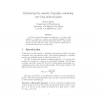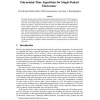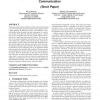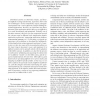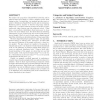ARSCOM
2008
15 years 1 months ago
2008
A (k; g)-graph is a k-regular graph with girth g. A (k; g)-cage is a (k; g)-graph with the least number of vertices. In this note, we show that (k; g)-cage has an r-factor of girt...
ARSCOM
2008
15 years 1 months ago
2008
Let P(n, k) denote the number of graphs on n + k vertices that contain Pn, a path on n vertices, as an induced subgraph. In this note we will find upper and lower bounds for P(n, ...
AAAI
2010
15 years 2 months ago
2010
For many election systems, bribery (and related) attacks have been shown NP-hard using constructions on combinatorially rich structures such as partitions and covers. It is import...
ATAL
2008
Springer
15 years 2 months ago
2008
Springer
The design of deterministic and fair mechanisms for selection among a set of self-motivated agents based solely on these agents' input is a major challenge in multiagent syst...
ECAI
2004
Springer
15 years 4 months ago
2004
Springer
Norms are essential to extend inference: inferences based on norms are far richer than those based on logical implications. In the recent decades, much effort has been devoted to r...
103
click to vote
APN
1994
Springer
15 years 5 months ago
1994
Springer
This paper shows how Coloured Petri Nets (CP-nets) can be extended to support synchronous communication. We introduce coloured communication channels through which transitions are...
150
click to vote
ICFP
1997
ACM
15 years 5 months ago
1997
ACM
We show how to implement a calculus with higher-order subtyping and subkinding by replacing uses of implicit subsumption with explicit coercions. To ensure this can be done, a pol...
110
click to vote
EDOC
2003
IEEE
15 years 6 months ago
2003
IEEE
Distributed systems are inherently complex, and therefore difficult to design and develop. Experience shows that new technologies—such as components, aspects, and application f...
129
click to vote
PODC
2004
ACM
15 years 6 months ago
2004
ACM
We analyze the properties of Small-World networks, where links are much more likely to connect “neighbor nodes” than distant nodes. In particular, our analysis provides new re...
ASPDAC
2004
ACM
15 years 6 months ago
2004
ACM
- This paper shows that divide-and-conquer derives a minimum sum-of-products expression (MSOP) of functions that have an AND bi-decomposition when at least one of the subfunctions ...

